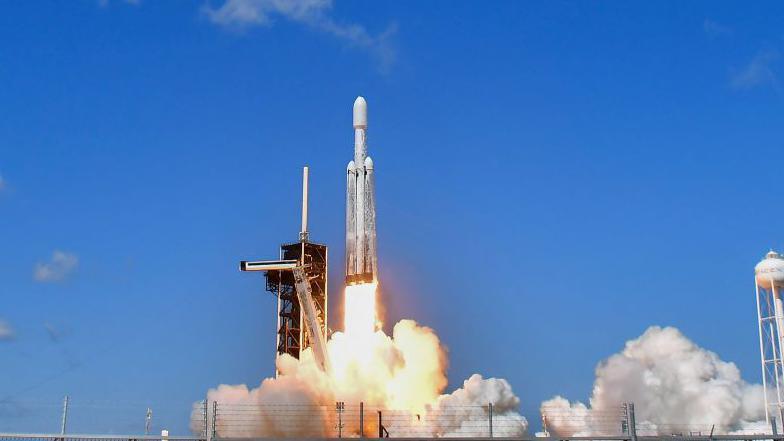Europa Clipper: Nasa's new Jupiter moon mission searching for alien life

- Published
An exciting new Nasa mission has launched into space in search of signs of alien life.
Europa Clipper set off from Cape Canaveral in Florida in the US, on 14 October on its long journey to Jupiter's icy moon - Europa.
It isn't expected to arrive until the year 2030, but that long journey was supposed to begin last week, it was pushed back after Hurricane Milton hit the state.
Clipper鈥檚 main goal is to investigate whether there are places below the surface of Europa that could support life.
It is the first time that the US Space Agency has sent a spacecraft to study an ocean world beyond Earth.
Keep reading to find out more about the mission and the Europa Clipper spacecraft.
More space news
- Published8 October
- Published1 October
What is Nasa's Europa Clipper mission?
Apart from Earth, Europa is thought to be one of the most promising habitable environments in our Solar System.
This is partly because experts say there's strong evidence which suggests it has an ocean of liquid water beneath its icy crust.
The Europa Clipper mission has three main goals.
Scientists want to understand about Europa's ice shell and the ocean beneath it, as well as find out about what its moon is made up of and its geology.
Ultimately, Nasa says it hopes that the detailed exploration of Europa will help scientists better understand whether there is the possibility of "habitable worlds beyond our planet" which means planets things can live on.
In order to do this, the spacecraft will orbit Jupiter when it arrives at the planet in 2030.
It will perform around 50 flybys of Europa, gathering detailed measurements to investigate the planet's icy moon.
Some of these will be as close as 16 miles above the surface, and Nasa hopes to scan nearly the entire moon by choosing a different location for each flyby.
How will Nasa's Europa Clipper get all the way to Jupiter?
Jupiter is the largest planet in our Solar System and has a magnetic field 20,000 times stronger than Earth's - so any spacecraft travelling to Jupiter needs special electronics that can deal with this.
Engineers and scientists, who work on the safe launch and travel of spacecraft, have been checking that the spacecraft is strong enough for Europa's atmosphere.
The team says they have avoided a 13-month delay by completing testing at Nasa labs across America.
The spacecraft will travel a whopping 1.8 billion miles on its mission, if you thought that would take a lot of fuel, you're not wrong.
So much so, that the Europa Clipper cannot carry enough fuel to get all that way alone.
Scientists have worked out a way that it can use the gravitational pull of Earth and Mars to help propel itself towards Jupiter.
Europa Clipper's design
The spacecraft has a unique design decorated with names, poetry and artwork to represent humanity's desire to explore space.
2.6 million names will be travelling in a protected vault on the spacecraft. Each name was written with an electron beam to engrave them onto a tiny microchip smaller than a five pence coin.
Each line of text is smaller than 1/1000th the width of a human hair (75 nanometres).
An original poem '' by US Poet Laureate Ada Lim贸n is etched under a design of a bottle floating within Jupiter's orbit.
There is also a portrait of planetary sciences pioneer , an Arizona State University professor who laid the foundations of the Europa mission.
There is a representation of sound waves and the word water written in 103 languages from across the world, including the American sign language symbol for water at the heart of the spiral.
What is Europa?
Europa is the fourth largest of Jupiter鈥檚 95 Moons - and is the sixth-closest moon to the planet.
With an equatorial diameter of 1,940 miles, Europa is about 90% the size of Earth鈥檚 Moon.
It is covered by a layer of ice up to 15 miles deep, which acts as a protective barrier against both solar radiation and the impact of an asteroid.
Scientists believe a saltwater ocean lies beneath its icy shell, which holds twice as much water as all the oceans on Earth.
Europa鈥檚 surface is full of dark, reddish-brown cracks, and according to experts, it appears to be no more than between 40 and 90 million years old.
- Published23 April 2022
- Published21 April 2022
- Published5 February
